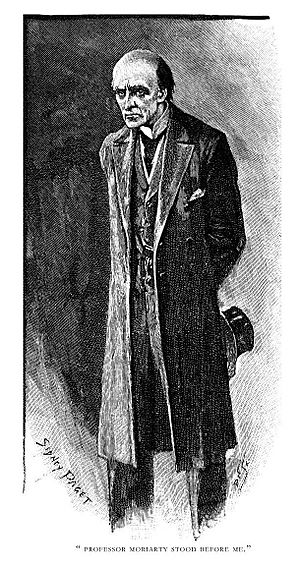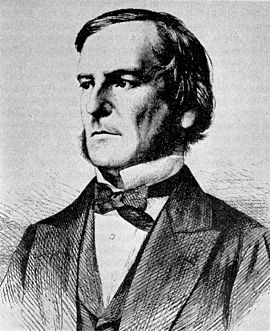Professor Moriarty facts for kids
Quick facts for kids Professor Moriarty |
|
|---|---|
| Sherlock Holmes character | |

Professor James Moriarty, illustration by Sidney Paget which accompanied the original publication of "The Final Problem"
|
|
| First appearance | "The Final Problem" (1893) |
| Created by | Sir Arthur Conan Doyle |
| Information | |
| Occupation | Professor of mathematics (formerly) Criminal mastermind |
| Family | One or two brothers |
| Nationality | British |
Professor James Moriarty is a fictional character and a very smart criminal from the Sherlock Holmes stories. He was created by Sir Arthur Conan Doyle. Moriarty is the main enemy of the famous detective Sherlock Holmes.
Doyle first created Moriarty so he could end the Sherlock Holmes stories. Moriarty first appeared in a short story called "The Adventure of the Final Problem" in 1893. He also plays a part in the book The Valley of Fear. Holmes talks about Moriarty in five other stories too.
Moriarty is a criminal genius. He uses his intelligence to help other criminals plan their crimes. He also helps them avoid getting caught by the police. In return, he gets paid or gets a share of their stolen money. Sherlock Holmes calls Moriarty the "Napoleon of crime." This means he is like a powerful general who controls a huge army of criminals. Even though Moriarty only appears in two of Doyle's original stories, many later books and movies show him as Sherlock Holmes's biggest enemy.
Contents
Moriarty's Appearances
Professor Moriarty first shows up in the 1893 story "The Adventure of the Final Problem". This story takes place in 1891. In it, Sherlock Holmes tells his friend, Doctor Watson, that he has been looking into many crimes. Holmes believes these crimes are all part of a huge plan by one very smart criminal group.
After investigating, Holmes finds out that Professor Moriarty is the leader of this group. Moriarty helps criminals with their plans and protects them from the law. In return, they must obey him and share their profits. Moriarty soon realizes that Holmes knows about his secret network. He then meets Holmes in person and threatens to kill him if Holmes interferes any more.
Holmes describes Moriarty's looks to Watson. He says the professor is very tall and thin. He has no beard, a pale face, and looks like he studies a lot. His forehead is big and round, and his eyes are deep-set. Holmes also says Moriarty's face moves from side to side like a reptile.
Holmes ignores Moriarty's threats. He gives the police enough proof to arrest Moriarty and his helpers in a few days. Moriarty and his top criminals plan to kill Holmes before they are caught. So, Holmes escapes to Switzerland, and Watson goes with him. Moriarty follows them.
Their chase ends when Moriarty finds Holmes at the top of the Reichenbach Falls. Watson does not see the fight. But he arrives later and finds signs of a struggle near the waterfall. This suggests that both men fell to their deaths. Watson also finds a goodbye note from Holmes. Moriarty had allowed Holmes to write it before their final battle.
Moriarty is also important in another Holmes story, The Valley of Fear (published in 1914). This story happens before "The Final Problem." In The Valley of Fear, Holmes tries to stop Moriarty's men from committing a murder. A police officer tells Holmes that Moriarty has a valuable painting in his office. Holmes points out that a university professor could not afford such an expensive painting. This shows that Moriarty makes money from crime.
Holmes mentions Moriarty in five other stories. These include "The Adventure of the Empty House", which is the next story after "The Final Problem". He also mentions him in "The Adventure of the Norwood Builder", "The Adventure of the Missing Three-Quarter", "The Adventure of the Illustrious Client", and "His Last Bow". "His Last Bow" is the very last adventure in Sherlock's timeline.
Doctor Watson never actually meets Moriarty face-to-face. He only sees him from a distance in "The Final Problem". Watson learns about Moriarty from Holmes. In "The Final Problem", Watson says he has never heard of Moriarty. But in "The Valley of Fear", which is set earlier, Watson already knows him as "the famous scientific criminal." This is a small mistake by Doyle.
In "The Empty House", Holmes says Moriarty ordered a powerful air gun from a German mechanic. Moriarty's helper, Colonel Moran, later uses this weapon. It looks like a walking stick, so it's easy to hide. It can fire bullets a long way and makes very little noise. Moriarty also likes to make his targets' deaths look like accidents. He tried to kill Holmes with falling bricks and a fast-moving horse cart.
Moriarty's Personality
Moriarty is very mean and determined. He tells Sherlock Holmes, "if you are clever enough to bring destruction upon me, rest assured that I shall do as much to you." Holmes describes Moriarty as a very powerful criminal leader. He is good at planning terrible crimes without feeling bad about them. In "The Final Problem", it says that Moriarty does not do the crimes himself. Instead, he plans everything and tells others what to do.
What makes Moriarty so dangerous is his incredibly smart mind:
He is a man of good birth and excellent education, endowed by nature with a phenomenal mathematical faculty. [...] But the man had hereditary tendencies of the most diabolical kind. A criminal strain ran in his blood, which, instead of being modified, was increased and rendered infinitely more dangerous by his extraordinary mental powers. [...] He is the Napoleon of crime, Watson. He is the organiser of half that is evil and of nearly all that is undetected in this great city...
Holmes says similar things in The Valley of Fear:
The greatest schemer of all time, the organizer of every devilry, the controlling brain of the underworld, a brain which might have made or marred the destiny of nations—that's the man! But so aloof is he from general suspicion, so immune from criticism, so admirable in his management and self-effacement, that for those very words that you have uttered he could hale you to a court and emerge with your year's pension as a solatium for his wounded character. [...] Foulmouthed doctor and slandered professor—such would be your respective roles! That's genius, Watson.
Moriarty respects Holmes's intelligence. He once said, "It has been an intellectual treat for me to see the manner in which you [Holmes] have grappled with this case." However, he still tries many times to kill Holmes using his agents. He gets very angry when his plans are ruined. When he was chasing Holmes at a train station, he pushed people aside angrily. He didn't care if it made people notice him.
Sir Arthur Conan Doyle created Moriarty because he wanted to end the Sherlock Holmes stories. "The Final Problem" was meant to be the last one. Doyle wanted Holmes to go out in a blaze of glory. Holmes would defeat a criminal so powerful that no other task would be important after that. But people wanted more Holmes stories, and Doyle needed money. So, he brought Holmes back. Doyle said Holmes did not die at Reichenbach Falls. However, he kept Moriarty dead. This is why The Valley of Fear, where Moriarty is active, takes place before "The Final Problem".
Moriarty's Background
In Doyle's stories, Moriarty first became known at age 21. He wrote a very important paper about math called "a treatise upon the Binomial Theorem". Because of this, he became a math professor at a small university in England. Moriarty later wrote another respected book called The Dynamics of an Asteroid.
After a while, people started hearing "dark rumors" about him in the university town. He had to quit his job and leave. He moved to London and became a private tutor for army officers. He also started working as a "consulting criminal mastermind." This meant he planned crimes for different gangs and criminals in London. When Sherlock Holmes started stopping his plans, Moriarty decided to target the detective.
Some other books and stories about Sherlock Holmes have added more details about Moriarty's past. For example, some say he was born in Ireland. Others say he was a professor at Durham University.
Moriarty's Family
The stories give different ideas about Moriarty's family. In his first story, "The Final Problem", he is called "Professor Moriarty." Watson mentions "Colonel James Moriarty" who defends his brother's memory. This suggests the Professor has a brother. In "The Adventure of the Empty House", Holmes calls him "Professor James Moriarty." This is the only time he is given a first name, and it's the same as his supposed brother.
In The Valley of Fear, Holmes says Professor Moriarty "is unmarried. His younger brother is a station master in the west of England." This makes it confusing. Does he have one brother who is both a colonel and a station master? Or two different brothers? Some writers think he has two brothers, both named James.
Real-World Inspirations

Doyle often used his own life experiences to create his characters. He went to a school called Stonyhurst. There were two boys with the last name Moriarty at his school.
Many people think Doyle based Moriarty on a real person named Simon Newcomb. He was a very smart astronomer from Canada and America. He was a genius in math and became famous. But Newcomb was also known for being mean and trying to ruin the careers of other scientists.

Moriarty might also have been inspired by two real mathematicians. Carl Friedrich Gauss wrote a famous paper about how asteroids move when he was young. Srinivasa Ramanujan wrote about math ideas that confused even the best mathematicians.
Some also suggest that Doyle got ideas from George Boole, an Irish mathematician. Another idea is that Moriarty was inspired by John O'Connor Power. He was an Irish political leader who was also a professor.
Some people at Doyle's old school, Stonyhurst, thought Moriarty's description matched a teacher there named Rev. Thomas Kay. Inspector MacDonald in the stories even says Moriarty "He'd have made a grand meenister with his thin face and grey hair and his solemn-like way of talking."
Doyle himself said that Moriarty was based on Jonathan Wild. He was a famous criminal from London in the 1700s. Holmes mentions this when trying to explain Moriarty to a police inspector.
Legacy
T. S. Eliot's famous cat character, Macavity the Mystery Cat, is based on Moriarty.
A group of Sherlock Holmes fans, called "The Brothers Three of Moriarty," was started to honor Professor Moriarty and his brothers. They used to have dinners in Moriarty, New Mexico.
See also
 In Spanish: James Moriarty para niños
In Spanish: James Moriarty para niños

